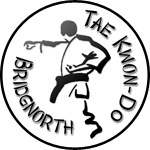Bridgnorth Tae Kwon-Do: Required Theory: 1st Kup: Black Stripe to Black Belt
Alongside your practical martial arts tuition at Bridgnorth Tae Kwon-Do, students are expected to learn theory and this is tested at the end of every grading. The emphasis is on the student to take responsibility for their own learning; but we have provided these theory sheets to assist and we are always happy to help with your learning or any questions you may have. In terms of timing for when is best to start your theory, we would always say ASAP! It is never too early or too late to start – the main thing is to give it your best effort in a way that suits you. Some students have created their own visual aids, drawn pictures, found ways to memorise dates, etc. No doubt you will learn more than the examiner will test you on – please don’t be disheartened by this. Your time spent on theory is never wasted. You need to know this information to perform at the highest level in the class; and you will be tested on all aspects of the syllabus from white belt onwards, during your Black Belt gradings.
(Korean terms are in brackets and italics).
Significance of Colours on Belts
BLACK is opposite of white, therefore signifies maturity and proficiency in Tae Kwon-Do. It also indicates imperviousness to darkness and fear.
Movements
- Bending ready stance B: (Gubiryo sogi B)
- Twin upward palm block: (Sang ollyo sonbadak makgi)
- Side X-knifehand checking block: (Yop kyocha sonkal momcha makgi)
- Back piercing kick: (Dwitcha jirugi)
- Twisting kick: (Bituro chagi)
- Flying side kick: (Twimyo yop chagi)
- Front knifehand strike: (Ap sonkal taerigi)
- Front reverse kinfehand strike: (Ap sonkal dung taerigi)
Pattern Meaning
Choong-Moo was the name given to the great admiral Yi Sun Sin of the Yi dynasty. He was reputed to have invented the first armoured battleship (Kobukson) which was the precursor of the present day submarine, in 1592 A.D. The reason why this pattern ends in a left hand attack is to symbolise his regrettable death having no chance to show his unrestrained potentiality checked by the forced reservation of his loyalty to the king.
Questions
- Why did you start Tae Kwon-Do?
- What is the difference between a colour belt and a black belt?
- What are the first two moves of Choong Moo used for?
- Why do we chamber?
- When would you use your toes to perform a kick?
- Name 5 patterns containing a backfist.
- Name 3 types of fingertip thrust.
- Name 3 patterns containing releases.
- What is the difference between dwit and dung?
- Why do we learn pattern meanings?
- Why do we pull the reaction hand back to the hip?
- What are your strengths? (Prepare to be challenged on this!)
- What are your weaknesses? (Prepare to be challenged on this!)
- How do you intend to improve? (Prepare to be challenged on this!)
- What are the purposes of stances?
- Name 3 patterns where we do a bending stance.
- Describe the history of Tae Kwon-Do.
- How do you know if a stance is a left or a right stance?
- Why is there a jump in Toi-Gye and Yul-Gok?
- What will you do if you get promoted to black belt?
- Name 3 kicks that use the heel.
- How have you changed since you were a white belt?
- How would you teach someone to do a walking stance?
- Why do we do slow motion movements?
- Name 5 vital spots on the upper body.
- (Philtrum, mandibular joint, jaw, eyes, Adam’s apple)
- Name 5 vital spots on the middle body.
- (Sternum, solar plexus, kidneys, floating ribs, stomach/abdomen)
- Name 5 vital spots on the lower body.
- (Coccyx, groin, instep, knee, shin)
- If a beginner asked why a blue belt was beating a black belt in sparring, what would you say?
- Why do we do a power test?
- Where do you see yourself in Tae Kwon-Do in five years?
- Why do we twist the fist when we punch?
- What does the last sentence of the meaning of Choong Moo actually mean?
- What makes a good Tae Kwon-Do student?
- If you had to suggest a 6th tenet what would it be, and why?
- What is your favourite pattern and why?
- Name 3 uses of the fingertips.
- What does indomitable spirit mean?
- What is Neo-Confucianism?
- Demonstrate a reverse punch in walking stance and in L-stance.
- What is Buddhism?
- How would you go about signing up a new member to your club?
- What does Tae Kwon-Do mean to you?
- What is the difference between Tae Kwon-Do as a sport, and an art?
- What can you offer your instructor if you become a black belt?
- Why do we do one-step sparring?
- What does the black trim on a black belt dobok signify?
- Name all the stances you know – in Korean.
- Name all the parts of the hand and foot – in Korean.
- When was the GTI formed?
- Describe how to do a side kick without moving.
- What are the names of the GTI Committee?
- What is the difference between the fixed stance side punch movement in Won-Yho and Hwa-Rang?
- Why do we learn Korean history/theory?
- What is the definition of power / how is power created?
*** The GTI Handbook contains more detailed theory information and is available to purchase from your Instructor at Bridgnorth Tae Kwon-Do.
The examiner may ask any question, not limited to those on these pages.
You must ALWAYS revise theory from previous belts…ESPECIALLY for a Dan Grading.***
